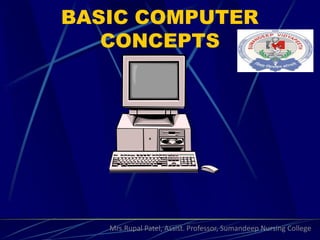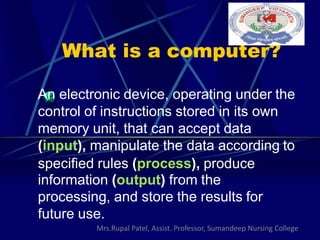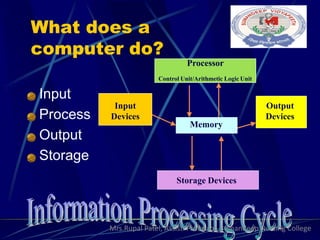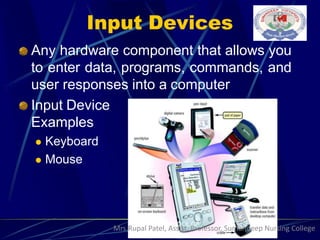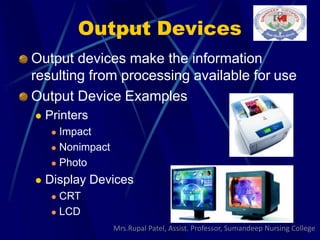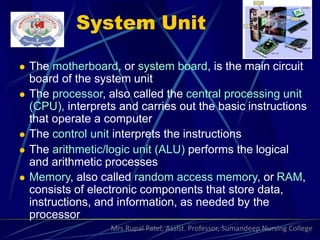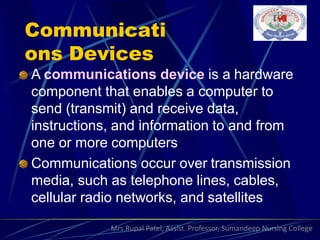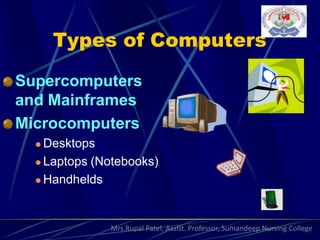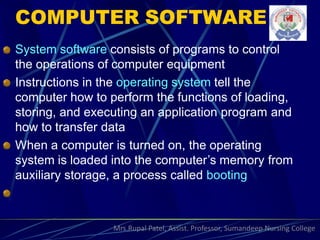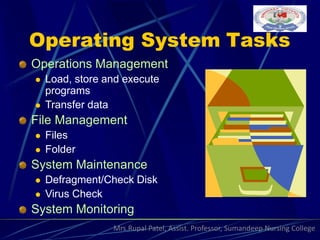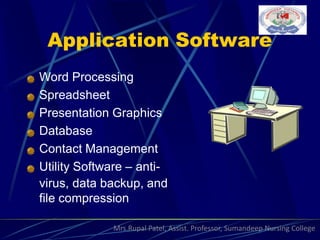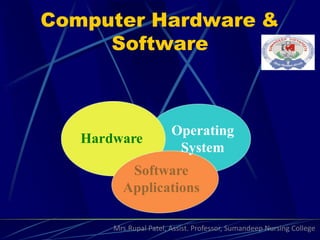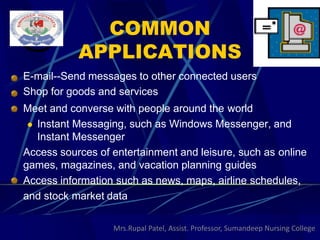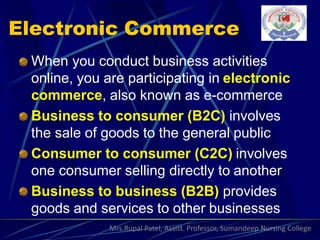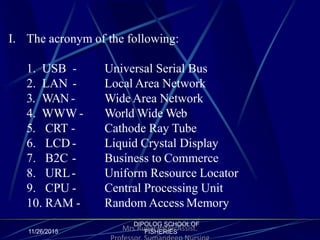Basic computer concepts
- 1. BASIC COMPUTER CONCEPTS Mrs.Rupal Patel, Assist. Professor, Sumandeep Nursing College
- 2. What is a computer? An electronic device, operating under the control of instructions stored in its own memory unit, that can accept data (input), manipulate the data according to specified rules (process), produce information (output) from the processing, and store the results for future use. Mrs.Rupal Patel, Assist. Professor, Sumandeep Nursing College
- 3. What does a computer do? Input Process Output Storage Processor Control Unit/Arithmetic Logic Unit Memory Storage Devices Input Devices Output Devices Mrs.Rupal Patel, Assist. Professor, Sumandeep Nursing College
- 4. Input Devices Any hardware component that allows you to enter data, programs, commands, and user responses into a computer Input Device Examples ’ü¼ Keyboard ’ü¼ Mouse SCHOOLOF Mrs.Rupal Patel, Assist. Professor, Sumandeep Nursing College
- 5. Output Devices Output devices make the information resulting from processing available for use Output Device Examples ’ü¼ Printers ’ü¼ Impact ’ü¼ Nonimpact ’ü¼ Photo ’ü¼ Display Devices ’ü¼ CRT ’ü¼ LCD Mrs.Rupal Patel, Assist. Professor, Sumandeep Nursing College
- 6. Storage Devices Removable ’ü¼ Floppy disk, or diskette ’ü¼ Compact Disc CD-R, CD-RW, CD-ROM ’ü¼ DVDs ŌĆō DVD-ROM, ’ü¼ Zip disk ’ü¼ USB drive ’ü¼ Tape Non-Removable ’ü¼ Hard disk Mrs.Rupal Patel, Assist. Professor, Sumandeep Nursing College
- 7. System Unit ’ü¼ The motherboard, or system board, is the main circuit board of the system unit ’ü¼ The processor, also called the central processing unit (CPU), interprets and carries out the basic instructions that operate a computer ’ü¼ The control unit interprets the instructions ’ü¼ The arithmetic/logic unit (ALU) performs the logical and arithmetic processes ’ü¼ Memory, also called random access memory, or RAM, consists of electronic components that store data, instructions, and information, as needed by the processor Mrs.Rupal Patel, Assist. Professor, Sumandeep Nursing College
- 8. Communicati ons Devices A communications device is a hardware component that enables a computer to send (transmit) and receive data, instructions, and information to and from one or more computers Communications occur over transmission media, such as telephone lines, cables, cellular radio networks, and satellites Mrs.Rupal Patel, Assist. Professor, Sumandeep Nursing College
- 9. Types of Computers Supercomputers and Mainframes Microcomputers ’ü¼ Desktops ’ü¼ Laptops (Notebooks) ’ü¼ Handhelds Mrs.Rupal Patel, Assist. Professor, Sumandeep Nursing College
- 10. COMPUTER SOFTWARE System software consists of programs to control the operations of computer equipment Instructions in the operating system tell the computer how to perform the functions of loading, storing, and executing an application program and how to transfer data When a computer is turned on, the operating system is loaded into the computerŌĆÖs memory from auxiliary storage, a process called booting Mrs.Rupal Patel, Assist. Professor, Sumandeep Nursing College
- 11. Operating System Tasks Operations Management ’ü¼ Load, store and execute programs ’ü¼ Transfer data File Management ’ü¼ Files ’ü¼ Folder System Maintenance ’ü¼ Defragment/Check Disk ’ü¼ Virus Check System Monitoring Mrs.Rupal Patel, Assist. Professor, Sumandeep Nursing College
- 12. Application Software Word Processing Spreadsheet Presentation Graphics Database Contact Management Utility Software ŌĆō anti- virus, data backup, and file compression Mrs.Rupal Patel, Assist. Professor, Sumandeep Nursing College
- 13. Computer Hardware & Software Hardware Operating System Software Applications Mrs.Rupal Patel, Assist. Professor, Sumandeep Nursing College
- 14. NETWORKS A network is a collection of computers and devices connected together so users can share data and resources A local area network (LAN) connects computers in a limited geographic area A wide area network (WAN) covers a large geographical area Mrs.Rupal Patel, Assist. Professor, Sumandeep Nursing College
- 15. Networks and the Internet The worldŌĆÖs largest network is the Internet Most users connect to the Internet in one of two ways: ’ü¼ Internet service provider ’ü¼ Online service provider Mrs.Rupal Patel, Assist. Professor, Sumandeep Nursing College
- 16. The World Wide Web One of the more popular segments of the Internet is the World Wide Web, also called the Web. A Web page is a document that contains text, graphics, sound, and/or video and has built-in connections, or hyperlinks to other Web documents A Web site is a related collection of Web pages You access and view Web pages using a software program called a Web browser A Web page has a unique address, called a Uniform Resource Locator (URL) Mrs.Rupal Patel, Assist. Professor, Sumandeep Nursing College
- 17. Web Browsers Internet Explorer ŌĆō built into Windows Netscape ŌĆō the oldest browser; an all- round communications package for the Internet; free at http://www.netscape.com Opera ŌĆō free version available at http://www.opera.com Mrs.Rupal Patel, Assist. Professor, Sumandeep Nursing College
- 18. COMMON APPLICATIONS E-mail--Send messages to other connected users Shop for goods and services Meet and converse with people around the world ’ü¼ Instant Messaging, such as Windows Messenger, and Instant Messenger Access sources of entertainment and leisure, such as online games, magazines, and vacation planning guides Access information such as news, maps, airline schedules, and stock market data Mrs.Rupal Patel, Assist. Professor, Sumandeep Nursing College
- 19. Electronic Commerce When you conduct business activities online, you are participating in electronic commerce, also known as e-commerce Business to consumer (B2C) involves the sale of goods to the general public Consumer to consumer (C2C) involves one consumer selling directly to another Business to business (B2B) provides goods and services to other businesses Mrs.Rupal Patel, Assist. Professor, Sumandeep Nursing College
- 20. THE END Mrs.Rupal Patel, Assist. Professor, Sumandeep Nursing College
- 21. DIPOLOG SCHOOLOF FISHERIES11/26/2015 I. The acronym of the following: 1. USB - 2. LAN - 3. WAN- 4. WWW - 5. CRT - 6. LCD - 7. B2C - 8. URL- 9. CPU - 10. RAM - Universal Serial Bus Local Area Network Wide Area Network World Wide Web Cathode Ray Tube Liquid Crystal Display Business to Commerce Uniform Resource Locator Central Processing Unit Random Access Memory Mrs.Rupal Patel, Assist.
